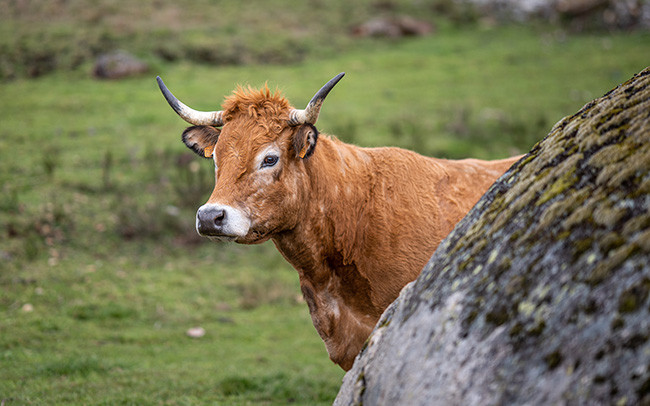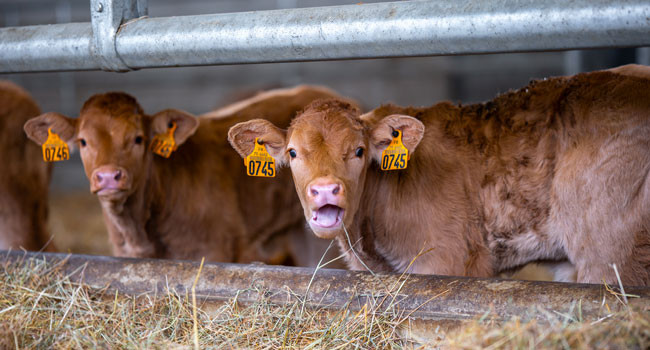Cheptel
BOVINS
La famille des bovins s’étend du veau au taureau, du bœuf à la vache et à la génisse. Quelles différences ? Le veau est un bovin mâle ou femelle de 8 mois maximum. Jusqu’à 12 mois, on parle de « bovin jeune », et entre 12 et 24 mois de « jeune bovin ». Un taureau est un mâle adulte non castré âgé de plus de 24 mois. Une fois castré, il devient un bœuf. Une génisse est une femelle adulte n’ayant pas vêlé, une fois qu’elle aura eu son premier veau elle devient une vache. La France possède le cheptel bovin le plus important d'Europe, avec 44 races représentées (Charolaise, Blonde d'Aquitaine, Rouge des Prés, Normande, Limousine, Gasconne, Aubrac...). Elles constituent un véritable patrimoine au cœur de nos campagnes.

Viande
Le terme viande s’applique au bovin mâle orienté vers l’engraissement, le plus souvent dans des ateliers d’engraissement spécifiques, différents de la filière laitière.
La filière vache allaitante, riche de la diversité des belles races françaises, produit des veaux qui naissent l’hiver dans la stabulation et sortent au printemps dans les pâtures.
Les différents types de Cornadis : AXIAL, RC ou bien FESTON Autobloquant, occupent une place de choix dans les élevages en permettant de canaliser les animaux et de réduire les perturbations à l’auge causées par les animaux dominants.
Le Cornadis sert également de contention sécurisée en restreignant un animal lors des interventions vétérinaires. Enfin, il aide aussi l’éleveur à trier ses animaux.

veaux
En filière laitière, le veau, après 20 jours passés en case individuelle, est ensuite placé en case collective, le plus souvent composée de barrières d’herbage et de Cornadis SAFETY veaux avec porte-seaux. La femelle sera conservée pour la relève de l’exploitation laitière tandis que le mâle, lui, partira sous 20 jours environ vers la filière viande.

lait
La filière de production laitière pour les industriels impose une production de masse où l’on retrouve le plus souvent une stabulation en logettes et matelas.
Ce type d’élevage repose sur une organisation optimisée de la distribution de l’aliment, de la gestion des effluents ainsi que de la traite robotisée, voire, sur les plus grosses installations, d’un système de traite par carrousel rotatif.
Le Cornadis SAFETY IV permet de canaliser les animaux et de réduire les perturbations entre animaux dominants. Le Cornadis sert également de contention sécurisée en restreignant un animal lors des interventions vétérinaires. Enfin, juste après la traite, il aide à maintenir l’animal en position le temps que les trayons se referment et à éviter des problèmes d’infections.
Dans les zones de production fromagère, et notamment les AOC, nous retrouvons le même type de fermes avec des cheptels plus petits mais orientés suivant un cahier des charges plus strict.
Le foin y est souvent la principale alimentation, et non l’ensilage, et les animaux sortent aux prés dès que la météo le permet. La production du fromage et l’affinage sont réalisés dans le laboratoire de l’exploitation, ce qui permet de développer un produit à plus forte valeur ajoutée.

OVIN
Les moutons sont élevés pour leur viande et leur lait. L’élevage s’organise autour de deux filières.
Les troupeaux dits « allaitants » produisent exclusivement de la viande d’agneau. Ils représentent autour de 90 % des exploitations ovines en France.
Les moutons sont soit élevés en grands troupeaux de plusieurs centaines de brebis, soit en complément d'autres productions. Cette présence des ovins est très souvent justifiée par la nécessité d'utiliser les parcelles et les ressources fourragères les plus pauvres ou seulement valorisables en prairies. Les races ovines bouchères les plus communes sont l’Île-de-France, le Charollais, le Suffolk et l’Hampshire.
Du côté des races laitières, les plus communes sont Lacaune, Basco béarnaise et Manech.
Les Cornadis ovin avec double cadre de réglage de l’encolure s’adaptent aux différentes races ovines sans corne. Le Cornadis ovin permet de travailler en libre-service de sécurité et de passer très simplement en position de blocage afin d’éduquer les agnelles au Cornadis. Associés à des barrières et claies à moutons, ils permettent de réaliser des cases d’agnelage.

cAPRIn
Les élevages de chèvres français produisent essentiellement du lait et du fromage mais aussi des chevreaux, pour la viande, dont une grande partie est exportée. Les races généralement rencontrées sont la Saanen, l’Alpine et la Poitevine. Pour un peu plus de la moitié des élevages français, le lait est collecté par les coopératives qui produisent ensuite le fromage. Pour les 47 % restant, la transformation du lait en fromage a lieu sur la ferme.
Le Cornadis chèvre permet de travailler en libre-service et de passer en position de blocage très simplement. Le tout, associé à nos barrières petit bétail et nos claies à chèvres, permet de réaliser aisément des séparations de lots.

ÉQUIN
Des races rustiques de trait aux chevaux de sang pour le sport et les centres équestres, la France compte de nombreuses races de chevaux. Nos box et râteliers sont conçus pour simplifier le logement et l’entretien des écuries. Le nettoyage mécanisé des boxes est simplifié par des façades en résine et des séparations coulissantes.
La résine est une matière composite issue de copeaux de plastique recyclés qui résiste aux chocs et au temps. Elle est totalement imputrescible et limite le grignotage des chevaux.
Nos différents modèles de parois pleines, barreaudées, fixes ou coulissantes permettent la création de box simples à utiliser et durables.


